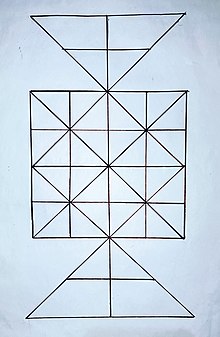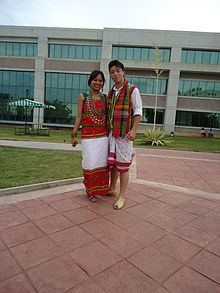Tipra People | |
|---|---|
 Tripuri woman and man in traditional attire | |
| Total population | |
| 1.2 million (2011) | |
| Regions with significant populations | |
| 1,011,294[1] | |
| Tripura | 950,875[1] |
| Mizoram | 32,634[1] |
| Assam | 22,890[1] |
| Meghalaya | 2,735[1] |
| Nagaland | 350[1] |
| Gujarat | 239[1] |
| Manipur | 208[1] |
| Jammu and Kashmir | 190[1] |
| Rajasthan | 169[1] |
| West Bengal | 120[1] |
| Maharashtra | 118[1] |
| Karnataka | 114[1] |
| 156,578 (2021)[2] | |
| Languages | |
| Kokborok (Tripuri) | |
| Religion | |
| Majority Minority See Tripuri people's Religion | |
| Related ethnic groups | |
| |
The Tripuri (also known as Tripura,[3][4] Tipra, Tiprasa, Twipra, Tipperah) are a Tibeto-Burman-speaking ethnic group of Northeast Indian state of Tripura. They are the descendants of the inhabitants of the Twipra/Tripura Kingdom in North-East India and Bangladesh. The Tripuri people through the Manikya dynasty[5] ruled the Kingdom of Tripura for ~450 years until the kingdom joined the Indian Union on 15 October 1949.

Tripuris are the native people of Tripura having its own unique and distinct rich culture, tradition, and history. They were able to expand their influence as far south as Chittagong Division, as far west as Comilla and Noakhali (known during the British period as "plains Tipperah") and as far north as Sylhet Division (all in present Bangladesh). Chittagong Hill Tracts was the part of Tipperah Kingdom till British took control of the Indian subcontinent. In the year 1512, the Tipperas were at the height of their supremacy when they defeated the Mughals. The ruling dynasty passed through several periods of history and ruled Tripura for several centuries until the 18th century, after which Plain Tippera became a colony of Britain and Hill Tippera remained an independent princely state. On 14 October 1949, Hill Tippera was merged into the newly independent India as Tripura State.
|
Main article: Kokborok language |
The Tripuri people speak Kokborok (also known as Tipra), a Tibeto-Burman language. Tripuri is the official language of Tripura, India. There are estimated to be more than one million speakers of the dialects of Tripuri in Tripura, and additional speakers in Mizoram and Assam in India, as well as Sylhet and the Chittagong Hill Tracts in Bangladesh. It is also spoken in Feni.
There are three main dialects of Tripuri, though the central dialect of the royal family, DebBarma (Puratan Tripur), is a prestige dialect understood by everyone. It is the standard for teaching and literature. It is taught as the medium of instruction up to class fifth and as subject up to graduate level in Tripura.
Historically, Tripuri was written in native Tripuri script known as Koloma, the earliest known writing in Tripuri dates from the 1st century AD, and was written in Koloma. The script was replaced by an alphabet based on the Eastern Nagari script. Currently the revival of ancient Koloma script is in process.
Some of the most notable Tripuri historical literary works, written by court scholars, include:
The Buisu[6] is the new year festival[7] of Tripuri/Tripura People in India and Bangladesh. This Festival is the traditional New Year's Day which falls on 13 or 14 April.
The Buisu Festival begins with Hari Buisu[8] which is the first day. In Hari Buisu Tripuri People clean up their houses and decorate their houses with different flowers. They pray a special prayer in the evening in their houses and temples. The next day is known as Buisu which is the main event, where people visit each other's houses. During this main Buisu, people actually socialize with each other. People cook different traditional foods along with others.
It's the seven day long festival, where Tripuri god Lord Goriya is worshipped starting from Buisu to Sena.
It's the last day of Goriya worship, where Lord Goriya gives all the household work back to Goddess Mailuma & Khuluma.
Kharchi mwtai is the worship of the dynasty deity of Tripuri people, the fourteen gods. It is performed in the month of July August on the eight day of new moon. The fourteen gods are worshipped by the royal priest Chontai.
Ker mwtai is celebrated 14 days following the end of Kharchi mwtai. It is the strictest puja ever performed by Tripuri people. It may be mentioned here that no puja or worship is so strictly performed as is the Ker of Tripuri people, by any section of the people in the world. In this also all the gods of Tripuri people are worshipped at a time.
The worship of Tripuri Goddess Ama Osa.
Mamita festival is the harvest festival of Tripuri people where the worship of goddess Ama Mailuma takes place. The Mamita festival is held during the time of Osa Mwtai.
Tripuri festival of lights where goddess Ama Mailuma & Ama Khuluma are worshipped. It is said that it the festival was stated during the reign of Tripuri King Subrairaja to create awareness among the Tripuri people during that era.
Hangrai[9] is a harvest festival and one of the main festivals of Tripuri people. This festival is very meaningful to Tripuri People. The Tripuris celebrate Hangrai with a festive way.[10] People start taking preparation of Hangrai which begins 4-5 days before. The younger generation make Nowshah, small huts made of bamboo and paddy husks. They gather for picnic where hot rice cakes and different foods are served. Elders would remain at home and take shower early in the morning and wear fresh clothes. They gather around and share their Awangs, Moi or Curries and rice-based alcohol Arak or chuwak. They enjoy the entire day until midnight.
In this festival Tripuri People visit holy places, worship God and perform individual sacrifices and rituals.[11]
In the 2011 census, 93.6% of the Tripuri people followed an admixture of Hindu and folk religions and 6.4% were Christians (mostly, Baptists). Tripuri Hinduism is a syncretic religion, melding traditional folk religion with Hindu elements, commonly found in northeastern India.[12] A minority of the Uchoi clan of the Tripuri are Buddhist.[13]
Tripuri people loves to eat different types of fresh vegetables from hill. In their food menu, Bamboo Shoots are one of the traditional dish which they call "Muya"[14] in their Kokborok Language.
The use of dry fish is common in their daily cuisine. Sticky rice which is one of the traditional food of Tripuri People and they eat sticky rice in different ways including Awang Bangwi/ Awang Bwthai,Awang Sokrang, Awang Phanswi, Phap ni Awang and Awang Belep[15]
Eight Traditional Recipes or Cuisines which Tripuri People eat in their daily life.[16]
Awang Bangwi or Awang Bwthai[18] which is one of the traditional food of Tripuri People. This cone shaped rice rolls in Lairu or banana leaves for steam which is loved by Tripuris. Awan Bangwi which is a rice cake prepared by Tripuris including sticky rice,butter or Ghee, reisins, nuts, ginger and onion.[19] Awan Bangwi is the national food of Tripura State.[20]
Using bamboo for cooking chicken or pork or fish is popular and traditional way of cooking process of Tripuri People. The process is simple. Marinating chicken or pork or fish with different ingredients and stuff the chicken/pork/fish inside the bamboo with little water. Then cook it for 40-50 min on Charcoal.
This Bamboo Chicken[21]/Pork/Fish is widely popular among Tripuri People.
|
Main article: Tripuri games and sports |

Like many parts of the world the Tripuri has traditional sports. It is common in almost all the clans of Tripuri. They are called thwngmung in Tripuri.
The main Tripuri clans are:

The Tripuri people consist of clans, each with its own elementary social and administrative organisation starting from the village level and up to the chieftainship of the whole community.[22]


These indigenous communities enjoy their traditional freedom based on the concept of self-determination. The relation between the king and the subject communities was as Maharaja (king) of Tripura-Missip or liaison officer Roy or headman of the community – Sardar the chief of the village – the individual. Earlier, only the Debbarma or Tipra ethnic group was included in the Tripuri Kshatriya group. Later, the Raja included other groups like Reang, Jamatia and Noatia as well, in an attempt to foster a sense of kindness among the people under his region.[23]
The Tripuri people have a rich historical, social, and cultural heritage which is totally distinct from that of the mainland Indians. Their distinctive culture – as reflected in their dance, music, festivals, management of community affairs, dress and food habits – has a strong base. Kokborok, the lingua franca of the 12 largest linguistic groups of the indigenous Tripuris and other dialects spoken in Tripura are of the Tibeto-Burman group and distinct from those spoken in India. There is no influence from those spoken by other peoples in the north-eastern region.
|
Main article: Tripuri calendar |
The Tripuris follow a traditional luni-solar calendar Tripurabda, which has 12 months and a 7-day week, like the Gregorian calendar.
The Tripura Era's New Year is on the 1st of Vaishakh which corresponds to 14 or 15 of April of Common_Era, depending on whether that year is a Leap year or not. The months are named in pan Indian months, time since its inception 1419 years back by Tripuri king Hamtor pha alias Himti pha alias Jujharu pha in 512 Saka Era.